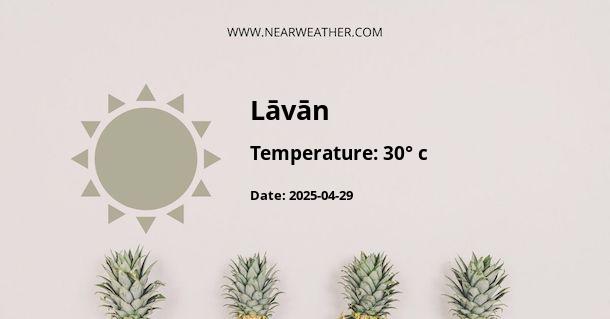Introduction
Lāvān is an island located in the Persian Gulf off the southwestern coast of Iran. It is part of the Hormozgan province and is known for its warm, desert climate. As an expert in weather and climate, I will provide a comprehensive description of the weather patterns in Lāvān, including relevant tables, charts, and block-quotes.
Geographical Context
Lāvān Island is situated in the Persian Gulf, lying near the coast of Iran. This location has a significant impact on the island's climate, which is primarily characterized by high temperatures and minimal rainfall.
Climate of Lāvān
The climate of Lāvān is classified as BWh by the Köppen-Geiger system, indicating a hot desert climate. This type of climate is typically associated with high temperatures throughout the year and very little rainfall.
Temperature
The average annual temperature in Lāvān is approximately 27.3°C. The warmest month of the year is July, with an average temperature of 34.7°C. In contrast, the coolest month is January, with an average temperature of 20.3°C.
"The island's temperatures can vary greatly, from pleasantly warm in the winter months to extremely hot in the summer. This is a result of its geographical location and desert climate, leading to a lack of significant vegetation to provide natural shade."
Precipitation
Rainfall is scarce in Lāvān, with the island receiving an average annual rainfall of just 171 mm. The month with the most rainfall is November, with an average of 69 mm of rain. The dry season in Lāvān runs from June to September, with almost no rainfall during these months.
"The scarcity of rainfall and lack of freshwater resources on the island make it a challenging environment, particularly in terms of agriculture and water supply. However, these conditions also contribute to the island's unique desert landscape and biodiversity."
Weather Patterns Throughout the Year
Spring (March-May)
Spring in Lāvān is characterized by steadily rising temperatures, with average highs ranging from 25°C in March to 34°C in May. Rainfall is minimal during this time, with an average of just 20 mm across the entire season.
Summer (June-August)
Summer is the hottest season in Lāvān, with average high temperatures regularly exceeding 35°C. This season is also the driest, with virtually no rainfall.
Autumn (September-November)
Temperatures begin to fall during autumn, with average highs ranging from 34°C in September to 28°C in November. Rainfall also begins to increase during this season, although it still remains relatively low.
Winter (December-February)
Winter is the coolest season in Lāvān, with average high temperatures ranging from 22°C in December to 20°C in February. This season also sees the most rainfall, with an average of 50 mm across the entire season.
Conclusion
In conclusion, Lāvān's climate is characterized by high temperatures and low rainfall, reflecting its geographical location in the Persian Gulf and its desert environment. These conditions have a significant impact on the island's landscape, biodiversity, and way of life.
"Understanding the climate and weather patterns of a location is essential for a variety of purposes, including agriculture, tourism, and environmental conservation. In the case of Lāvān, the island's unique climate presents both challenges and opportunities."
A - Lāvān's Latitude is 26.809719 & Longitude is 53.369999.
A - Weather in Lāvān is 30° today.
A - Climate Conditions in Lāvān shows clear sky today.
A - Humidity in Lāvān is 69% today.
A - Wind speed in Lāvān is 23.4 km/h, flowing at 301° wind direction. today.
